In a recent article published in the AGCSA Turf Management Magazine, our turf agronomist John Neylan writes about the vital best practices to adopt when it comes to a construction project to ensure an optimal outcome.
Here's below the transcript of the article, with the AGCSA graceful authorisation.
Having worked in the turf industry for over 35 years, it is definitely one of continually learning about what works and what doesn’t and this particularly applies to construction projects. John Neylan has been involved in numerous construction projects over this time as the turfgrass agronomist, working with a range of disciplines including civil engineers, contractors, turf managers, sand suppliers and turf growers.
Over the past couple of years, John has been working as a turfgrass agronomist with SPORTENG. Pivotal to the company’s approach is not only understanding the specific design requirements for the Field of Play but appreciating how the facility will be constructed, operated and maintained.
Over the time that John has worked in the turf industry, there have been many lessons learned with the most poignant fact being that the attention to small details will make for a successful and a relatively painless project.
Since working with SPORTENG, John has come to better appreciate the importance of experience, good design, detailed specifications and a methodical approach to understanding each site and each project. What follows are some of the key areas that need particular attention and some take home messages for any facility looking at undertaking a construction project.
Understanding the client brief
Understanding the client’s brief can often be the most challenging part of any project. If the requirements of the project aren’t clearly defined it is very difficult to design to the brief.
Many an hour can be wasted on a design that when it is presented to the client comes back with the response of “that’s not what we really want”.
The client brief can also include some personal preferences including profile depth, soil type (“we don’t want a sand profile”), grass selection and drainage layout. Many of the requests can be worked into the design, but some we know just won’t work. The ability to discuss these aspects in a technical and methodical manner without embarrassing anyone is most important. If there are aspects of the brief and design that don’t quite meet best practice, the client must be made aware of the possible ramifications.
TAKE HOME MESSAGE: Take the time to truly understand the client brief.
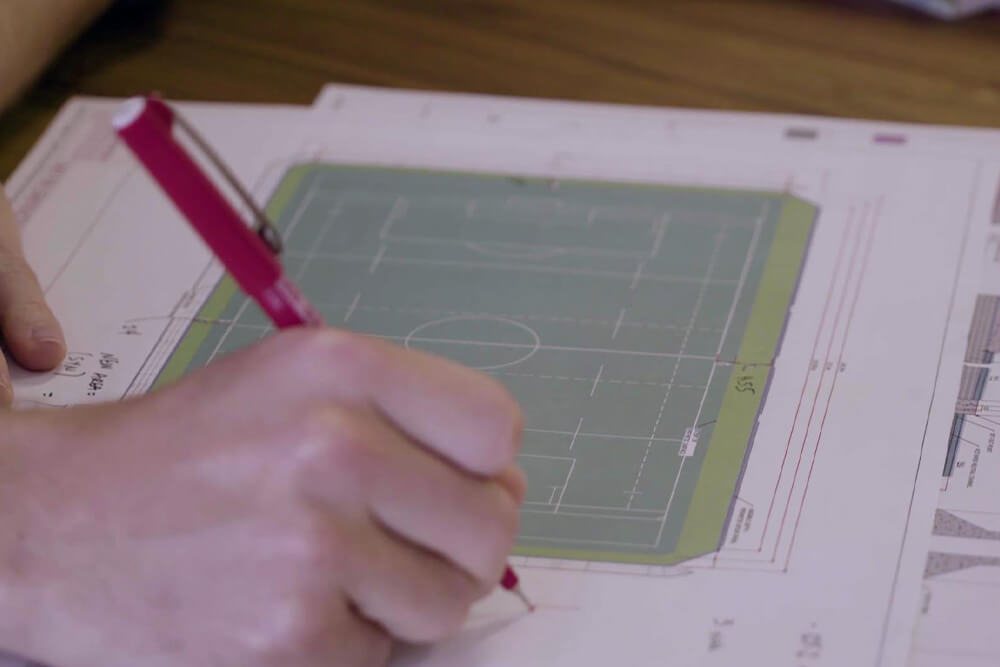 Understanding the client’s brief can often be the most challenging part of any project. If the requirements of the project aren’t clearly defined it is very difficult to design to the brief.
Understanding the client’s brief can often be the most challenging part of any project. If the requirements of the project aren’t clearly defined it is very difficult to design to the brief.
Picking between upgrading or building brand new
Not all projects will be on a green field site and it will involve either an upgrade or reconstruction of an existing field. In this scenario, the options can be many as to how the field can be improved. In this situation, there are two key questions:
- What are the current concerns?
- What is the desired outcome?
While these are relatively simple questions, it can take a bit of effort to tease out the answers and to gain a clear understanding of why the field is not performing and what is the standard of playing surface required. This links in strongly to understanding the client’s brief.
With an existing field, a detailed site assessment is required and should include:
- Undertake a level survey.
- Assessing the existing soil conditions including the depth of the rootzone soil. This must include sampling and testing the soils to determine whether they can be reused.
- Measuring the depth of thatch/organic matter as this will affect the depth/volume of material that needs to be removed.
- Evaluating the irrigation system to determine whether it may be upgraded or a new system is required. This includes pumps, tanks, sprinklers and pipework.
- Identifying the turf species/variety and weeds.
- Identifying any key wear areas and localised depressions.
- If it is an old fill site, a geotechnical investigation will often be necessary to determine whether there is any soil contamination.
- Where possible gather the available information on the hours of use and the numbers of users.
Based on this information, it is then possible to decide whether the existing profile can be upgraded or whether a total rebuild is the best option.
TAKE HOME MESSAGE: Understand what you are dealing with!
What is the subrage condition?
The subgrade is the base on which the turf profile is constructed and whether it is a sports field, golf green or racetrack, the integrity of that base is fundamental in achieving a successful outcome. Unstable, poorly compacted or reactive subgrades will often result in subsidence and localised mounding which will impact the integrity of the playing surface.
In the time that John has worked with SPORTENG, there have been numerous projects undertaken on both green field sites and existing fields that have inbuilt problems which affect the formation of the subgrade including reactive clays, contaminated soils, uncompacted soils, saturated soils/high water table, uncontrolled fill and rock.
It goes without saying that it’s important to know what you are building on. There have been many older sports fields built on old refuse dump sites and land that was too poor to put buildings on. It is only when the new profile is being constructed that contaminated soil, unconsolidated fill and localised water tables can be discovered. Depending on the knowledge of the site, a geotechnical investigation is often warranted to determine the subsoil conditions. At the very least it may be required to dig out soft areas and replace with select fill.
Where contaminated soils are detected and depending on the class of contamination, it may be required to lay an orange geofabric as an indicator that there are contaminated soils below.
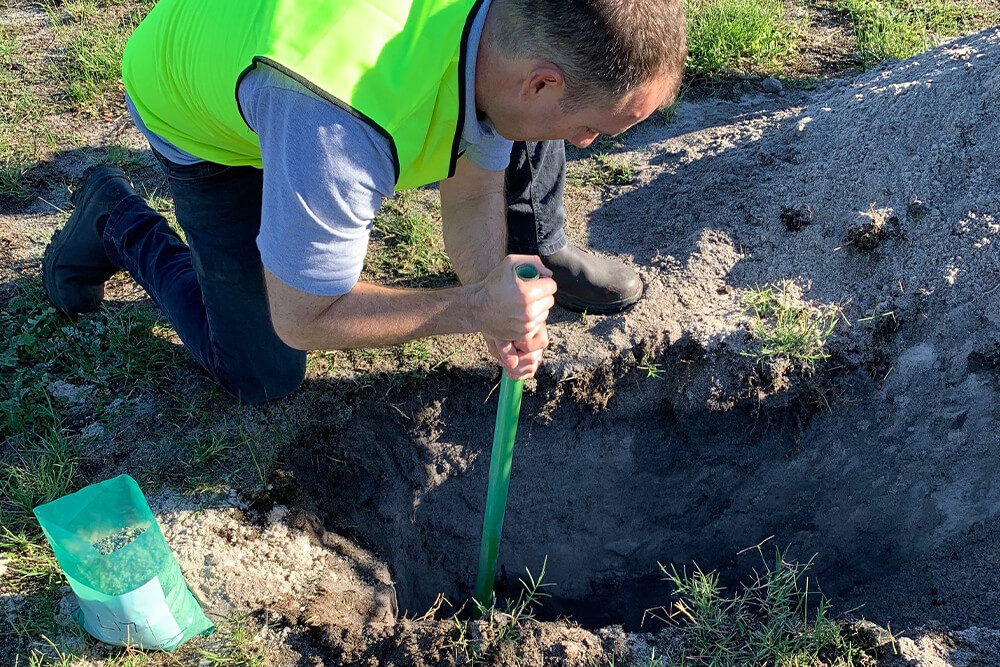 Understand what you are dealing with. With an existing site, a detailed assessment of soil conditions, including sampling and testing, is critical to determine whether they can be reused.
Understand what you are dealing with. With an existing site, a detailed assessment of soil conditions, including sampling and testing, is critical to determine whether they can be reused.
On green field sites that have native clay soils, these soils can often be highly reactive.
Reactive clay soil is a dense material that changes in volume when it absorbs and releases moisture. This absorption and release occurs as seasons change throughout the year. When it’s warm and dry, reactive clay soil releases moisture and contracts. In cooler, wetter periods, reactive clay soil takes on moisture and expands.
On sports fields in particular, the expansion of the clays appears to be the main problem where there will be localised mounding in the playing surface as the soil expands. Installing a capping layer consisting of a non-reactive material is often required so that a stable platform can be formed on which to construct the turf profile.
The only viable solution in many situations is to install a capping layer and then building a perched water table profile using flat drainage panel technology so there are no intrusions into the capping layer. There are obviously cost implications where reactive soils occur including the cost of the capping layer and the necessity of installing a gravel drainage layer.
The other problem associated with reactive soils is where drains are trenched through the reactive soil which then results in compromising of the drains as well as the localised expansion of the soil and localised irregularities in the playing surface.
TAKE HOME MESSAGES: Research the local geological conditions and the history of the site (e.g. was it a tip). Undertake geotechnical investigations and be sure to communicate with the client.
Committing time to planning
Committing time to planning is the key to success for any project or program. As obvious as it sounds, there are many examples of where projects are rushed and there is insufficient time committed to sitting, thinking, discussing (arguing), producing a draft of the plan and specifications, reviewing and then finalising. Being time poor is an often quoted problem for turf managers, however, when it comes to a new project time must be set aside to plan thoroughly, exploring all the things that could go wrong and the possible constraints on the project.
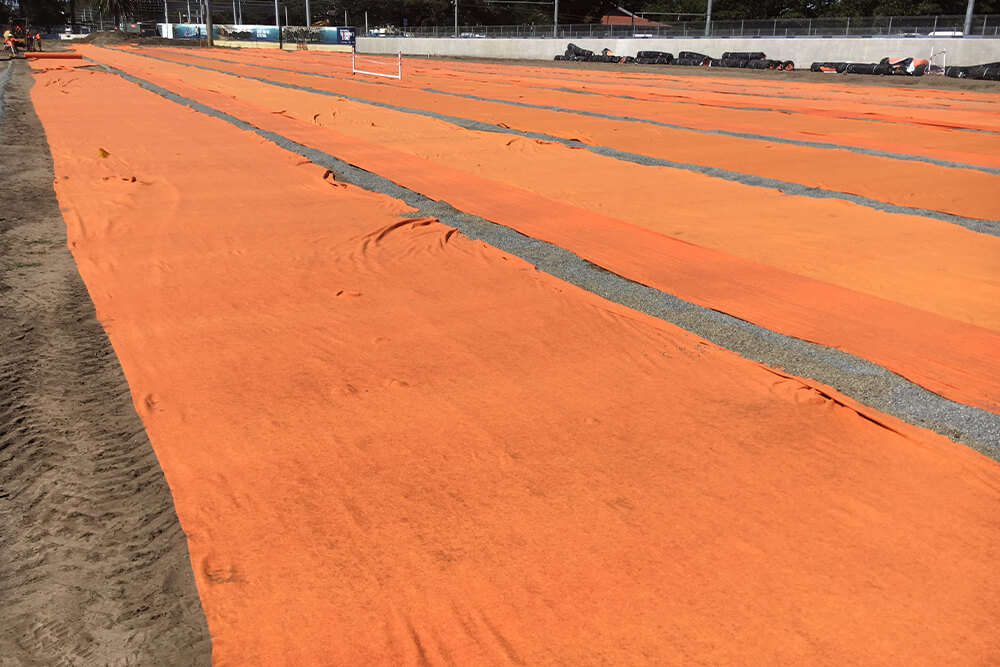 It goes without saying that it’s important to know what you are building on. Where contaminated soils are detected, it may be required to lay an orange geofabric as an indicator that there are contaminated soils below.
It goes without saying that it’s important to know what you are building on. Where contaminated soils are detected, it may be required to lay an orange geofabric as an indicator that there are contaminated soils below.
Many projects have an ‘impossible’ timeframe and an unrealistic expectation of the end product within the constraints of the due by date. This seems to be the way of modern life and can only be dealt with through detailed planning.
It is always advisable to look at the preferred date of completion and work backwards, firstly to see what time of year the turf is likely to be laid and the earliest date the project can feasibly start. For example, having to plant warm-season grasses in winter is not going to help if the field has to be ready for the start of the cricket season. If an earlier start date is required it may mean that the user groups will have to vacate before the end of their season. Communication is key in working the client through the likely outcomes and the restraints.
TAKE HOME MESSAGE: Review the ‘completion date’ and then work backwards. Is the timeframe achievable?
What part does speciations and documentation play?
The specifications and documentation for any project are crucial to the outcome of that project. The specification is a detailed set of requirements to be satisfied by the materials, design, product or service. A specification is a type of technical standard that sets the parameters within which the project must operate. The more detailed the specification in terms of materials and process, the less opportunity there is for shortcuts to be taken. It is also important to note that in times of dispute the specification will be the primary reference point when determining responsibility.
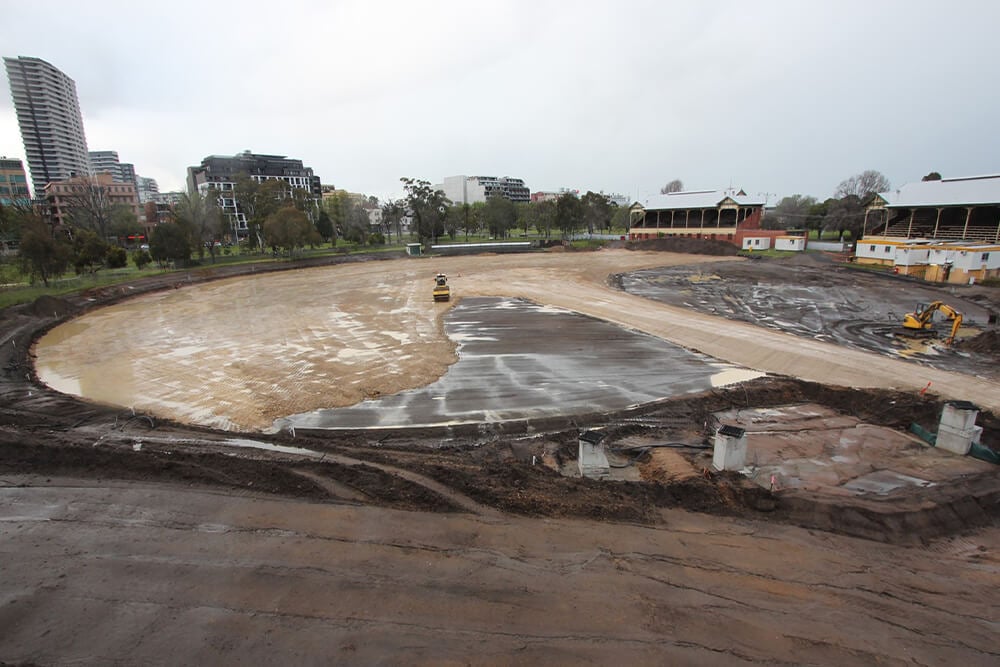
On reactive soil sites, installing a capping layer consisting of a non-reactive material is often required so that a stable platform can be formed on which to construct the turf profile.
The specification must have a set of hold points at which the quality of work and materials are checked before works can proceed. These may be:
- Completion of base works;
- Installation of drainage (including trenching, gravel and pipework);
- Irrigation system installation;
- Gravel and rootzone installation (including properties); and
- Turf establishment.
The great weakness of any specification is how the project is then managed and adhering to the specification and the hold points.
TAKE HOME MESSAGE: The specifications must clearly detail the process, the testing requirements and the hold points.
Managing the possible constraints
Every project will be subject to some type of constraint whether it is known at the time of planning or occurs unexpectedly once the project commences. The constraints that have appeared in recent projects that John has been involved with include reduced supplies of the correct gravels and sands, environmental impacts, rock and/or contaminated soils, poor water supplies, turf quality and conflicting advice from regulatory authorities.
These types of constraints are not new, however, taking the required time to assess the site of the project and thoroughly investigating each of the important elements means that you will be forewarned and then better able to plan.
TAKE HOME MESSAGE: Be prepared for contingencies. Stop, review and advise.
Supplying the appropriate sands and gravels
In several areas of Australia the ability to source the appropriate sands and gravels is becoming more difficult. As pits become depleted or there are demands for materials by other industries, the specific needs for a turf project can be difficult to achieve.
It is not only sourcing the appropriate materials that meet the specification, but also ensuring that the volume of material of consistent quality can be provided. If you are responsible for sourcing the gravel and sand, the process involves;
- Specifying the physical and chemical parameters of the sand and gravel;
- Collecting typical samples;
- Testing the prospective materials in an accredited laboratory and then deciding on the best source.
Once the materials are selected, the preferred samples become the benchmark for the project. These benchmark samples are then the reference point for all future samples taken as part of the quality control process.
Testing throughout the project can be a challenge if the materials begin to drift outside of the agreed envelope. A problem that John has noted is that some material suppliers either do not understand the precise nature of the specification for turf projects or underestimate their ability to deliver materials of consistent quality throughout the project. In deciding on the supplier of materials it must include discussions with the supplier in terms of their understanding of the specification and whether they can deliver the tonnage required.
Many sands that the turf industry deals with are processed sands that may involve particle size manipulation through washing, sieving and blending. Blending materials can often be problematic, particularly where the characteristics of the raw materials are not clearly understood. Small movements in the silt and clay content in particular can have a dramatic effect on drainage and moisture etention. Consistency is the key.
If a principle contractor is employed to undertake the works it is not always possible to control the source of the materials. However, it should be requested that the contractor nominates the source of the materials and to provide a capability statement from the supplier in terms of experience and processes employed (including internal testing).
TAKE HOME MESSAGE: Do not compromise on quality.
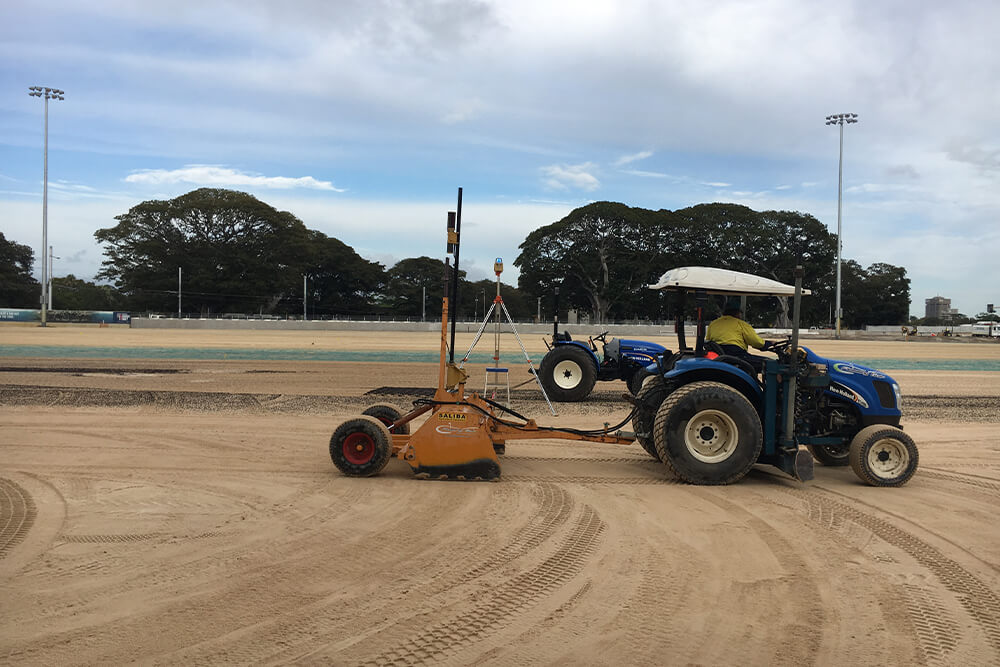
The more detailed a specification is in terms of materials and process, the less opportunity there is for shortcuts to be taken which can create problems further down the line.
Securing water supply
Water is the limiting factor for many new projects. For example, a new golf course is likely to be remote from a secure water supply and will eventually be relying on stormwater collection, recycled and bore water and rivers.
The key questions are: is the water readily available, what infrastructure needs to be put in place to get the water to the site, what permits are needed and are there any environmental constraints?
Almost invariably the water supply is left to last and the volumes required are grossly underestimated, particularly during the construction and establishment process. When multiple areas on a site are being worked on and juvenile turf being established, there can be a substantial strain on the water source.
TAKE HOME MESSAGE: Securing a sustainable water supply must be at the top of the list.
Selecting contractors and subcontractors
Selecting a contractor can be a stressful process, particularly if they are unknown and do not necessarily have a proven track record.
A few points to consider and questions to ask include:
- What projects have they undertaken and the size of the projects?
- What is the expertise of the staff employed?
- What equipment do they have?
- What subcontractors do they use (e.g. irrigation, grow-in)?
Interview prospective contractors and quiz them on the processes they employ.
From recent experiences, contractors tendering for work will often come up with alternatives for the construction of the profile, drainage layout, grassing options and irrigation. An experienced and wellcredentialed contractor can value add to the project and well-considered alternatives should be considered. However, if you have planned the project thoroughly and there are particular elements that are important to you, don’t compromise.
Tender review is an interesting process and on large projects an experienced project manager can be useful in working through all of the elements and deciding if the costs quoted for each component are realistic.
Prices that are at odds with what you may expect them to be or are dramatically different to other tenders could be due to:
- A genuine mistake;
- Misinterpretation of the specification;
- Reflects poor quality materials;
- Complexity of the work; or
- The profit margins are too high.
Again the specification is very important in creating tight parameters that the contractors must work within when pricing the project. If there are discrepancies ask for clarification.
TAKE HOME MESSAGE: The cheapest price may not provide the intended outcome.
Establishing and maintaining the turf
The quality of the turf and its establishment is both the most exciting part of the project and the most exasperating. The specification must describe the quality requirements of the turf, sprigs and seed, how they are to be established and maintained.
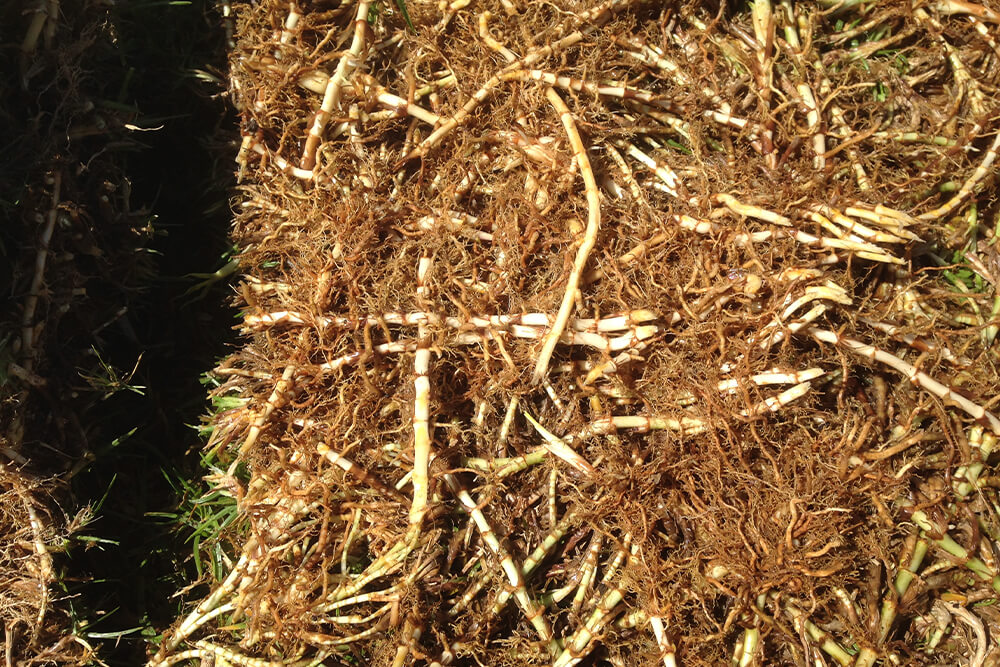 Washed turf certainly avoids any problems with contaminating the rootzone with incompatible soils, however, can provide a challenge especially when being laid and established during hot weather.
Washed turf certainly avoids any problems with contaminating the rootzone with incompatible soils, however, can provide a challenge especially when being laid and established during hot weather.
In John's experience the quality and consistency of the turf can vary, particularly if iit comes from different farms. The most likely variables are that the turf is not necessarily the variety specified and the condition of the turf is poor (i.e. variations in turf density, health, thatch, weeds, purity etc…). The end product can be a patchwork effect with some areas establishing more quickly than others and then there is the variation in the appearance of the surface.
The delivery of turf during hot weather can be a major challenge and must be on the truck for the minimum amount of time, delivered over night or early morning and laid immediately (and watered). Turf during hot weather can increase in temperature quite dramatically and will invariably result in scald marks and turf loss.
Washed turf is used extensively on sand profiles and during hot weather it can provide considerable challenges. While it seems incredibly obvious, water is the absolute key to success. As soon as the turf is laid it must be watered and watering by hand is strongly advised. During the first week or so the turf and underlying sand must be kept moist at all times and it is imperative the irrigation system is capable of providing the required amounts of water.
Washed turf certainly avoids any problems with contaminating the rootzone with incompatible soils, however, turf with a compatible soil backing does assist the establishment process. Even a thin layer of a compatible soil type will assist in retaining moisture which reduces the problems of transplant shock. Whether grassing involves solid turf, sprigs or seed, a high level of fertility is essential.
From recent experiences the fertility can drop off very quickly, particularly on sand profiles.
Regular fertilising with nitrogen, phosphorus and potassium is required to ensure recovery from transplant shock and the generation of root systems, stolons and rhizomes and to promote strong shoot growth. On most sand profiles, a base of a controlled release nitrogen source will provide a buffer against leaching losses, however, the quick-release fertilisers are considered to be more effective during the establishment process.
TAKE HOME MESSAGE: It is essential to inspect the turf farms supplying the turf and the sprigs. Reject poor quality turf as it will set the project back and closely monitor the establishment process.
When is it the best time to handover a completed project?
When to take over the completed works is a vexed question. Do you take it over as soon as possible or allow the contractor to maintain the turf until it is ready for play? There is no straight answer, however, in John's experience, the sooner the greenkeeping staff take over the turf management the quicker a playable surface is developed. Once the turf is planted/laid/seeded there can at times be a relaxation in the intensity of work, particularly if the contractor does not have a dedicated and experienced turf management team.
Allowing the turf management team to take over the works early often provides the opportunity for more of the ‘fine-tuning’ processes to be employed such as reducing cutting heights, increasing mowing frequency, dethatching and dusting that may not be reflected in the specifications for the grow-in period.
Conclusion
The basics of good construction have not changed. A detailed specification, thorough planning, selecting the correct materials and attention to detail are some of the key elements to a successful outcome. Once you have decided on what you want, stick to it and do not let price compromise the job.

